Manifestations, Detection and Approach to Bullying and Cyberbullying from the Teachers’ Perspective: A Mixed Study in Spanish School Contexts
Abstract
1. Introduction
2. Materials and Methods
2.1. Study Design
2.2. Participants and Sampling
2.3. Instruments
2.4. Procedure
2.5. Data Analysis
3. Results
3.1. Descriptive Analyses
- Gender
- Age
- Autonomous Community
- Professional experience
- Type of educational establishment
- Educational level at which they work
- Employment status
3.2. Quantitative Results
3.2.1. Conceptual Understanding of Bullying and Cyberbullying
- Between 8.1 and 8.2: ρ = 0.592 (p < 0.001)
- Between 8.1 and 8.3: ρ = 0.531 (p < 0.001)
3.2.2. Detection Capability
3.2.3. Prevention of Bullying and Cyberbullying
3.2.4. Intervention in Cases of Harassment
3.2.5. Institutional Presence and Teacher Training
3.2.6. Perceived Training Needs
3.3. Qualitative Results (ATLAS.ti)
3.3.1. Meanings Attributed to Bullying and Cyberbullying
- Three broad categories with six main subcategories were generated from the inductive analysis applied to the interviews.
- The quotes reveal varied conceptions: from structured definitions based on power imbalance and intentionality, to more ambiguous approaches in which the boundary between conflict and harassment is blurred.
- An emerging category is the evolution of the notion of bullying over time: several teachers reported that their current understanding of bullying is more nuanced and complex than when they started teaching.
3.3.2. Real Experiences and Barriers to Detection
- Most accounts point to a structural difficulty in observing and confirming bullying, especially when it does not manifest itself physically.
- There is recurrent criticism of the lack of clear protocols and the lack of specialised training to detect early signs, which generates a sense of professional helplessness.
- The culture of silence—both among students and school structures—emerges as a critical barrier to addressing the phenomenon, reinforcing the idea that detection does not depend solely on the will of teachers, but on systemic conditions.
3.3.3. Teaching Strategies and Intervention Frameworks
- Teachers show a willingness to intervene, but the strategies applied are often informal, intuitive and not systematised.
- There are strong emotional barriers linked to the fear of acting inappropriately or provoking conflicts with families or the management team.
- The absence of clear institutional frameworks means that responses to bullying depend more on individual judgement than on a common strategy, leading to inequality of care.
3.3.4. Training Demands and Expectations of Teachers
- Teachers ask for practical, contextual training, focused on real cases and concrete tools for action.
- A strong expectation of institutional support is evident: without managerial support or coordination, teachers feel unprotected.
- The demands are oriented not only to individual training, but also to the improvement of the organisational structure and resources, which shows a systemic perspective on the solution of the problem.
3.3.5. Teachers’ Conceptualisations and Barriers to Detection of Bullying and Cyberbullying
“Sometimes they fight and we wonder if it’s bullying or just a conflict between peers.”
“Perhaps if I hadn’t had prior information, I could have considered them as specific problems of coexistence.”
“We don’t have a clear protocol for action. Everyone does what they can.”
“Everything was dealt with by the head office, but the rest of the teaching staff were not told about it.”
“I prefer to talk to them before imposing a sanction. Listen first.”
“Addressing the issue through films and questionnaires can help, but it is not enough if there is no institutional follow-up.”
3.3.6. Constant Training Demands
“They give us lectures, yes, but what we need is to know how to act step by step in a real case.”; “I did not receive any training related to bullying or cyberbullying during my master’s degree.”
4. Discussion
5. Conclusions
Author Contributions
Funding
Institutional Review Board Statement
Informed Consent Statement
Data Availability Statement
Conflicts of Interest
References
- Baraldsnes, D., & Caravita, S. C. S. (2025). The relations of teacher use of anti-bullying components at classroom and individual levels with teacher and school characteristics. International Journal of Bullying Prevention, 7, 1–15. [Google Scholar] [CrossRef]
- Betts, L. R., & Spenser, K. A. (2017). Teachers’ perceptions towards cyberbullying: A systematic review. Nottingham Trent University IRep. Available online: https://irep.ntu.ac.uk/id/eprint/34401/1/11833_a1049_Betts.pdf?utm_source=chatgpt.com (accessed on 17 September 2025).
- Bronfenbrenner, U. (1979). The ecology of human development: Experiments by nature and design. Harvard University Press. [Google Scholar]
- Creswell, J. W., & Plano Clark, V. L. (2018). Designing and conducting mixed methods research (3rd ed.). SAGE Publications. Available online: https://bayanbox.ir/view/236051966444369258/9781483344379-Designing-and-Conducting-Mixed-Methods-Research-3e.pdf (accessed on 17 September 2025).
- Creswell, J. W., & Poth, C. N. (2018). Qualitative inquiry and research design: Choosing among five approaches (4th ed.). SAGE Publications. [Google Scholar]
- Dawes, M., Malamut, S. T., Guess, H., & Lohrbach, E. (2024). Teachers’ attitudes toward bullying and intervention responses: A systematic and meta-analytic review. Educational Psychology Review, 36, 122. [Google Scholar] [CrossRef]
- Flick, U. (2015). Introducing research methodology: A beginner’s guide to doing a research project (2nd ed.). SAGE Publications. [Google Scholar]
- Fundación ColaCao & Universidad Complutense de Madrid. (2025). First large-scale study on school bullying and cyberbullying in Spanish childhood and adolescence. Fundación ColaCao. [Google Scholar]
- Halah, A. (2023). Teachers’ perceptions of bullying in Saudi Arabian primary public schools: A convergent parallel mixed-method study. Children, 10(12), 1859. [Google Scholar] [CrossRef]
- Malamut, S. T., Dawes, M., & Lohrbach, E. (2024). Teachers’ awareness and sensitivity to a bullying incident: A qualitative study. International Journal of Bullying Prevention, 6(1), 45–60. [Google Scholar] [CrossRef]
- Malamut, S. T., Dawes, M., & Lohrbach, E. (2025). An international investigation of variability in teacher perceptions of and intervention intentions in bias-based bullying situations. International Journal of Bullying Prevention, 7, 1–20. [Google Scholar] [CrossRef]
- Maran, D. A., & Begotti, T. (2022). Teachers and inclusive practices against bullying: A qualitative study. Journal of Child and Family Studies, 31(2), 456–468. [Google Scholar] [CrossRef]
- Menabò, L., Skrzypiec, G., Slee, P., & Guarini, A. (2022). What roles matter? An explorative study on bullying and cyberbullying. British Journal of Educational Psychology, 92(4), 1095–1112. [Google Scholar] [CrossRef]
- Mishna, F., Birze, A., & Greenblatt, A. (2022a). Qualitative methods in school bullying and cyberbullying research. International Journal of Bullying Prevention, 4(2), 59–70. [Google Scholar] [CrossRef]
- Mishna, F., Birze, A., & Greenblatt, A. (2022b). Understanding bullying and cyberbullying through an ecological systems framework: The value of qualitative interviewing in a mixed methods approach. International Journal of Bullying Prevention, 4(2), 71–83. [Google Scholar] [CrossRef] [PubMed]
- Peabody, A. D. (2023). A qualitative case study to examine teachers’ perceptions of bullying within K-12 institutions. World Journal of Advanced Research and Reviews, 19(1), 369–374. [Google Scholar] [CrossRef]
- Sainz, M., & Martín-Moya, R. (2021). School interventions for bullying-cyberbullying prevention in adolescents: A European perspective. International Journal of Environmental Research and Public Health, 18(21), 11697. [Google Scholar] [CrossRef]
- Save the Children. (2025). Breaking the silence on school bullying: National statistics 2025. Save the Children Spain. [Google Scholar]
- Stauffer, S. (2011). High school teachers’ perceptions of cyber bullying: Prevention and intervention strategies. Brigham Young University Scholars Archive. Available online: https://www.researchgate.net/publication/264121964 (accessed on 17 September 2025).
- Strauss, A., & Corbin, J. (2002). Basics of qualitative research: Grounded theory procedures and techniques. SAGE Publications. Available online: https://methods.sagepub.com/book/mono/basics-of-qualitative-research/toc?utm_source=chatgpt.com#_ (accessed on 17 September 2025).
- Tashakkori, A., & Teddlie, C. (2020). Foundations of mixed methods research: Integrating quantitative and qualitative approaches in the social and behavioral sciences (2nd ed.). SAGE Publications. [Google Scholar]
- Zambuto, V., & Martín-Moya, R. (2021). Teachers’ perceptions and position regarding the problem of bullying in schools. Behavioral Sciences, 14(3), 229. [Google Scholar] [CrossRef]
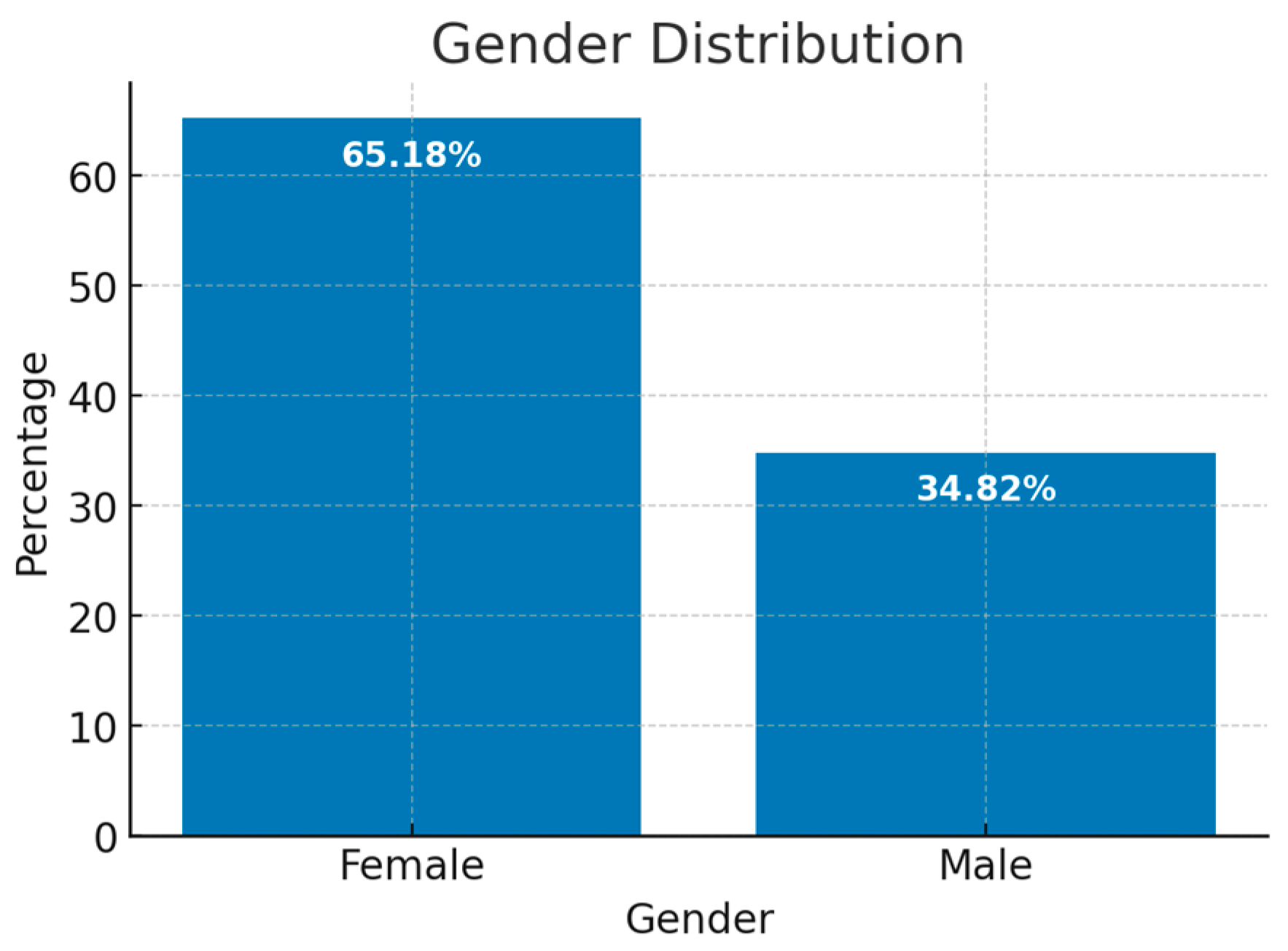
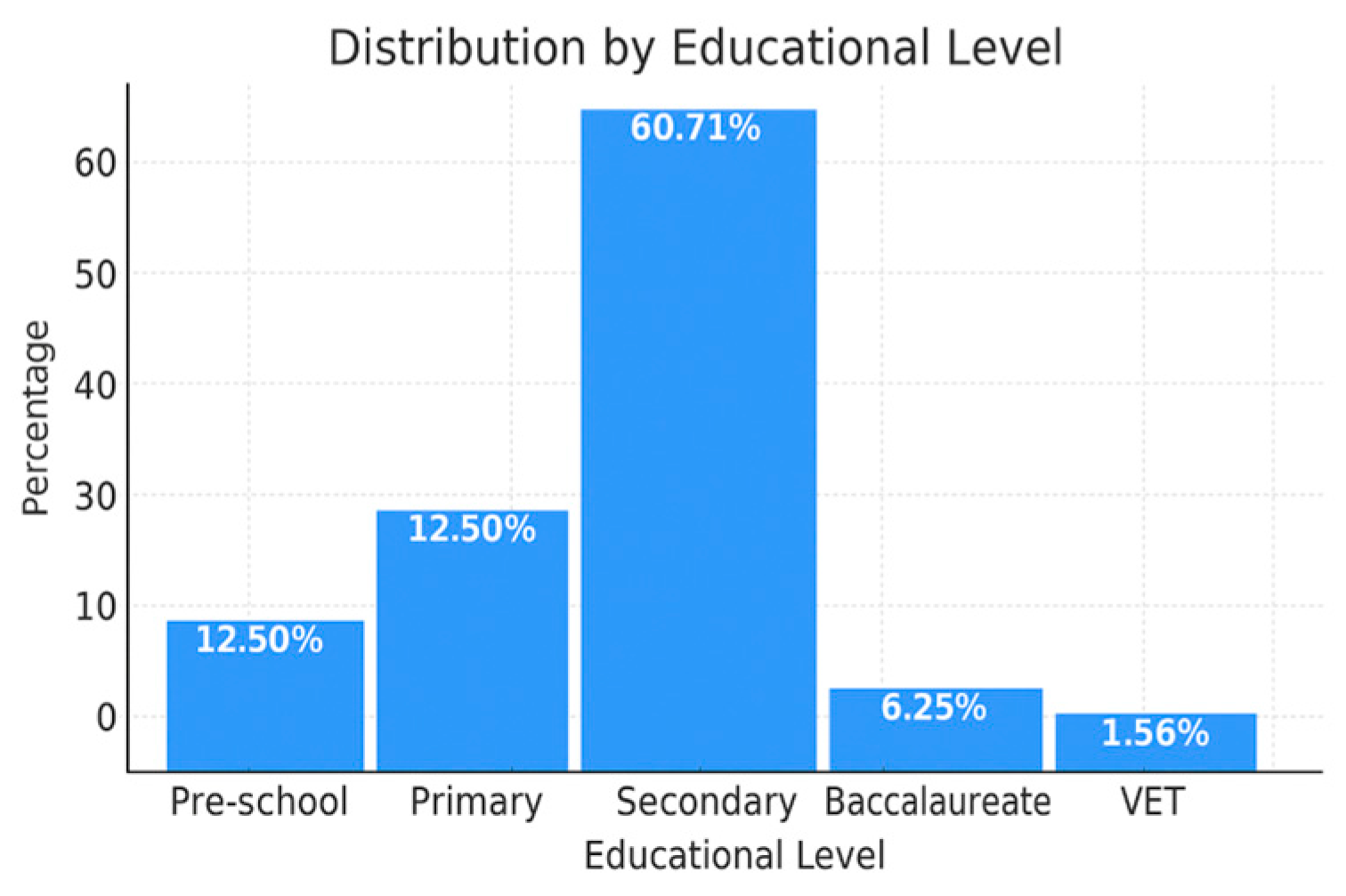
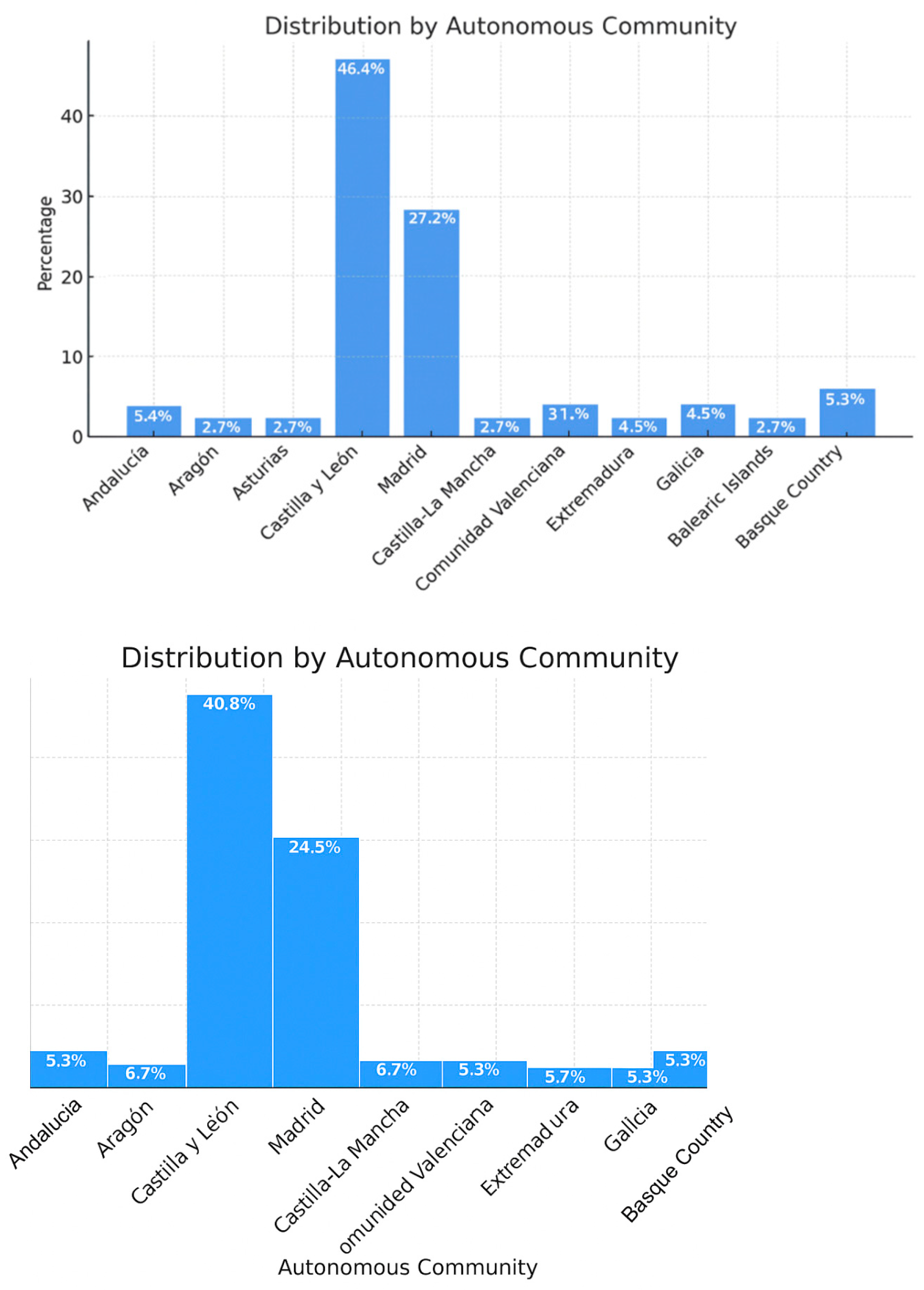
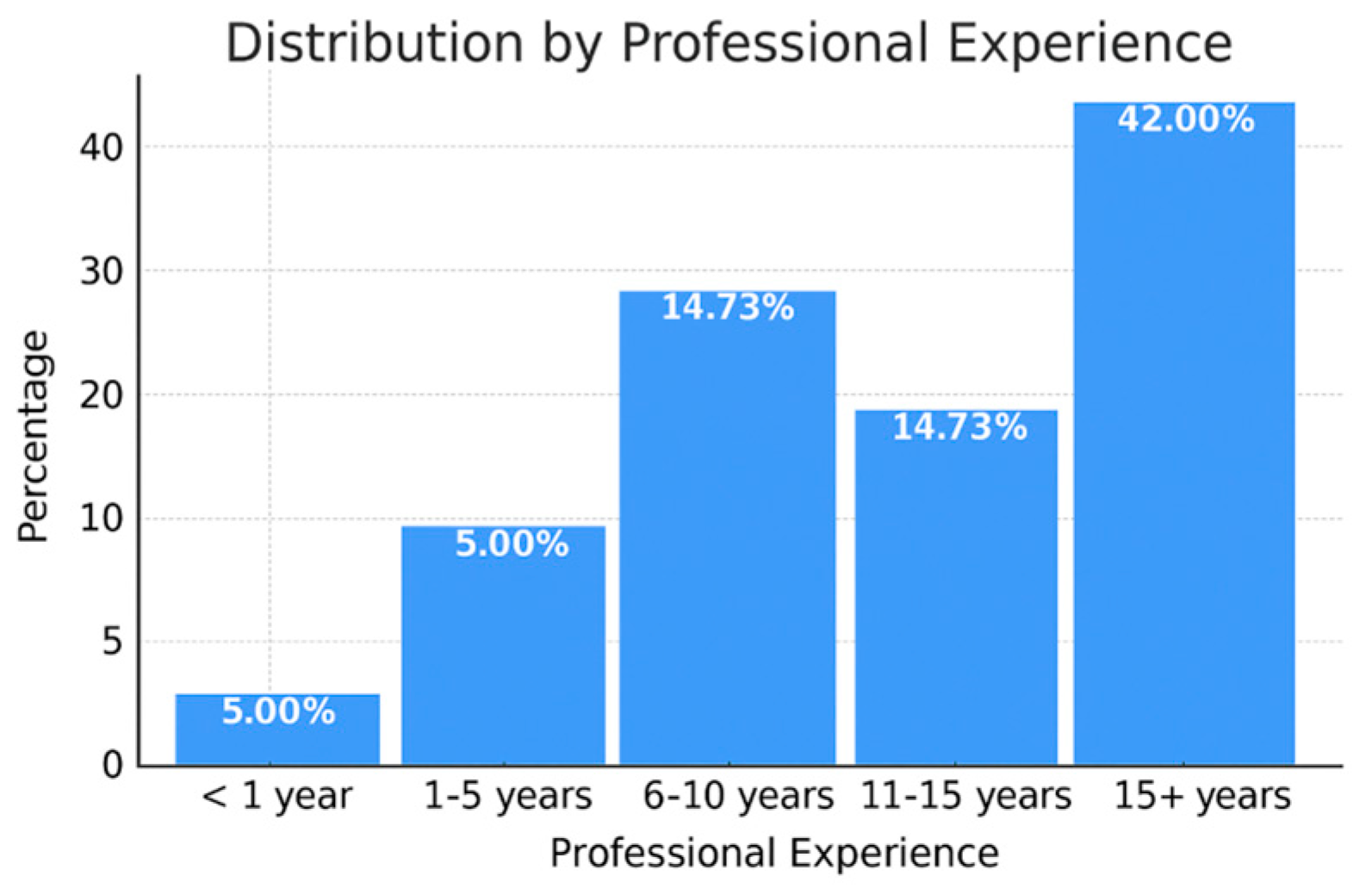
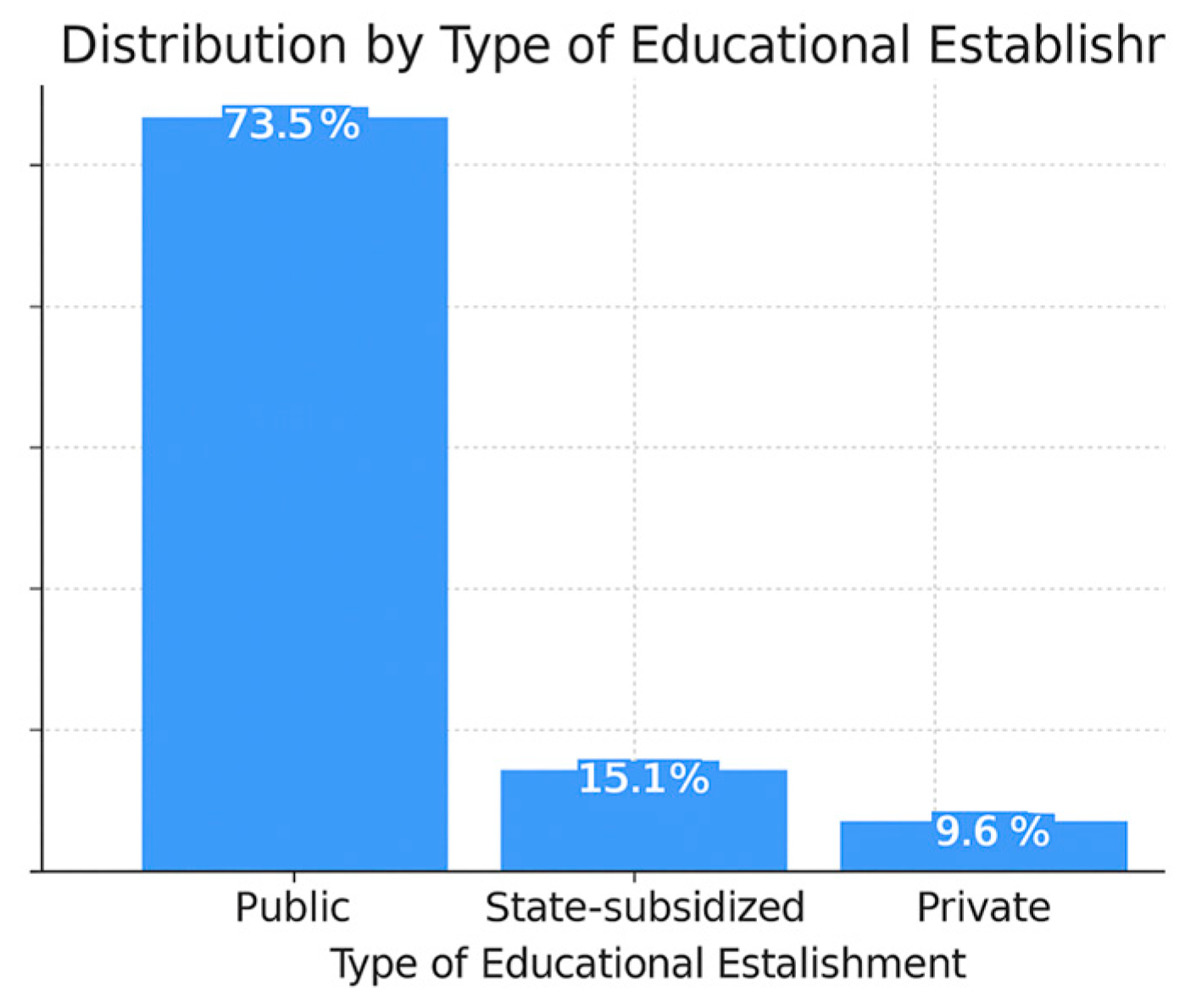
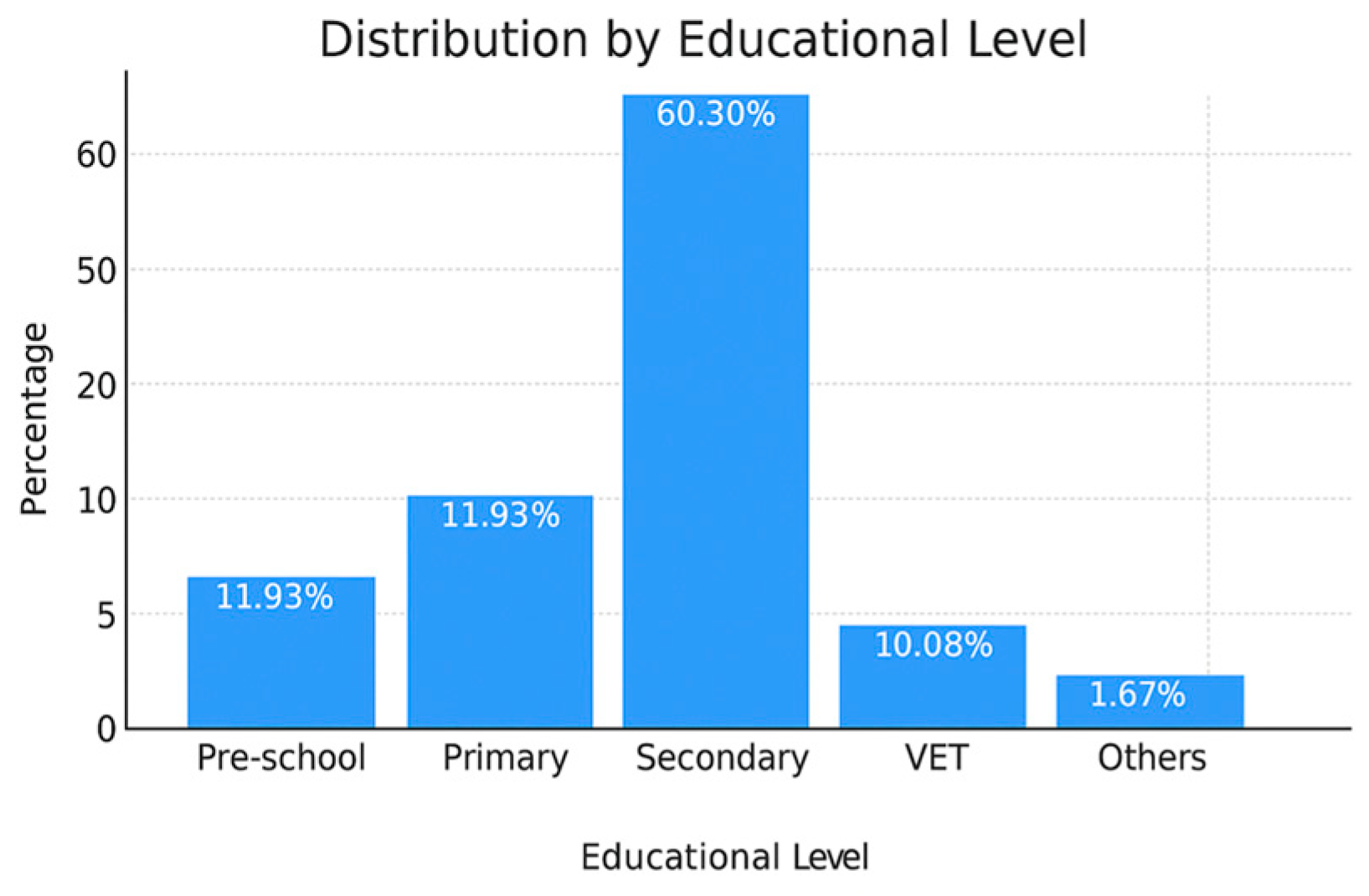
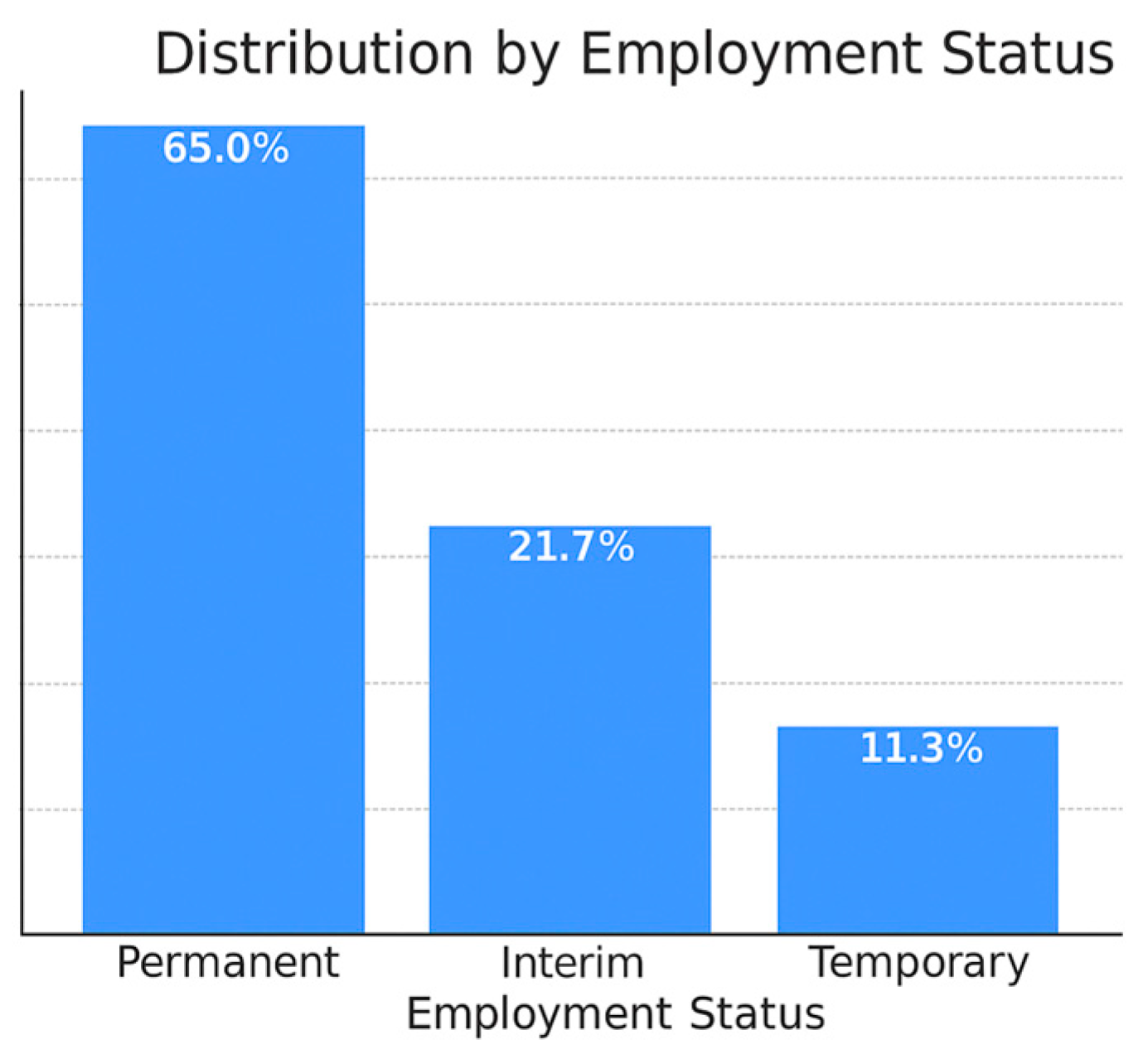
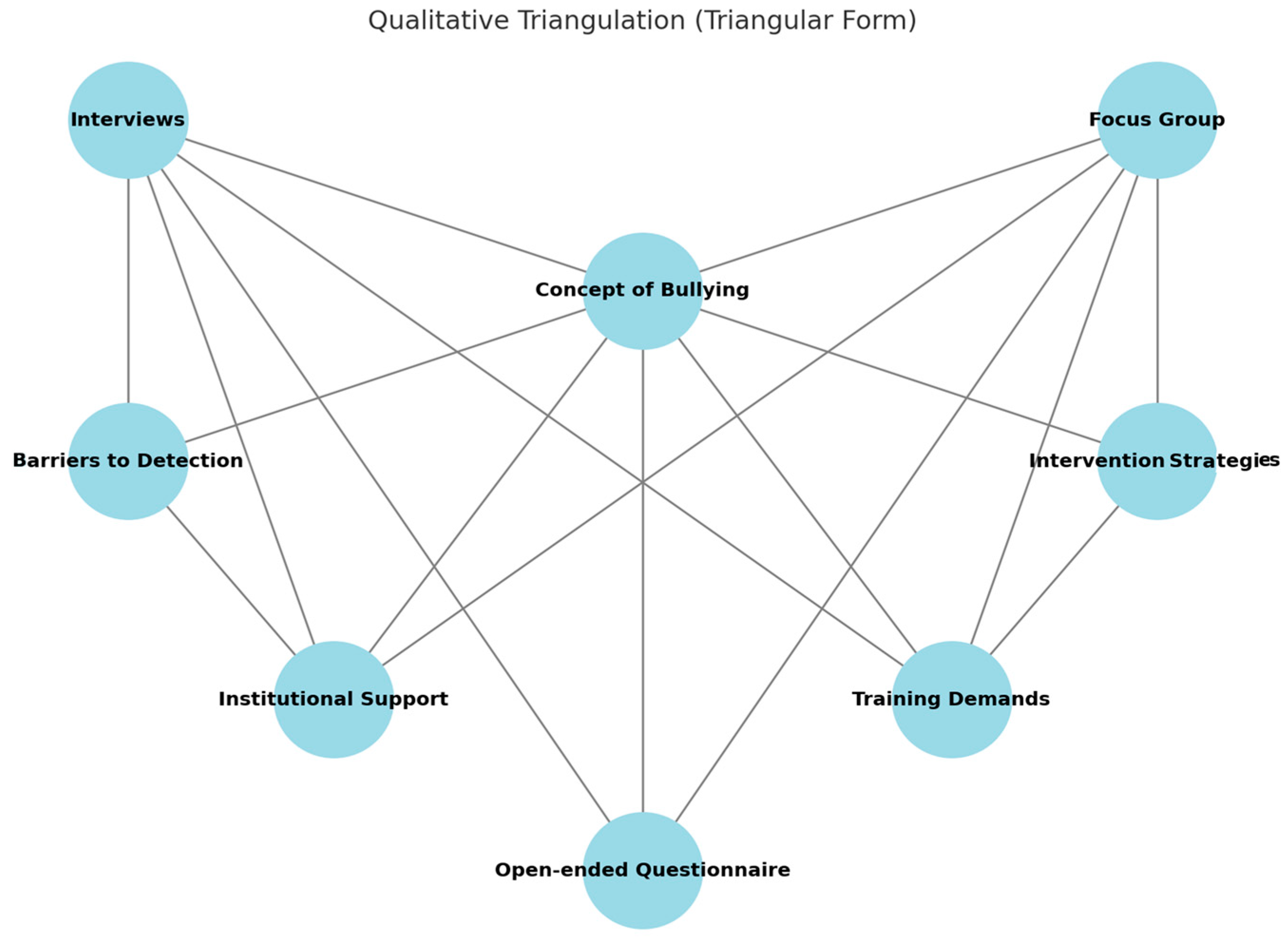
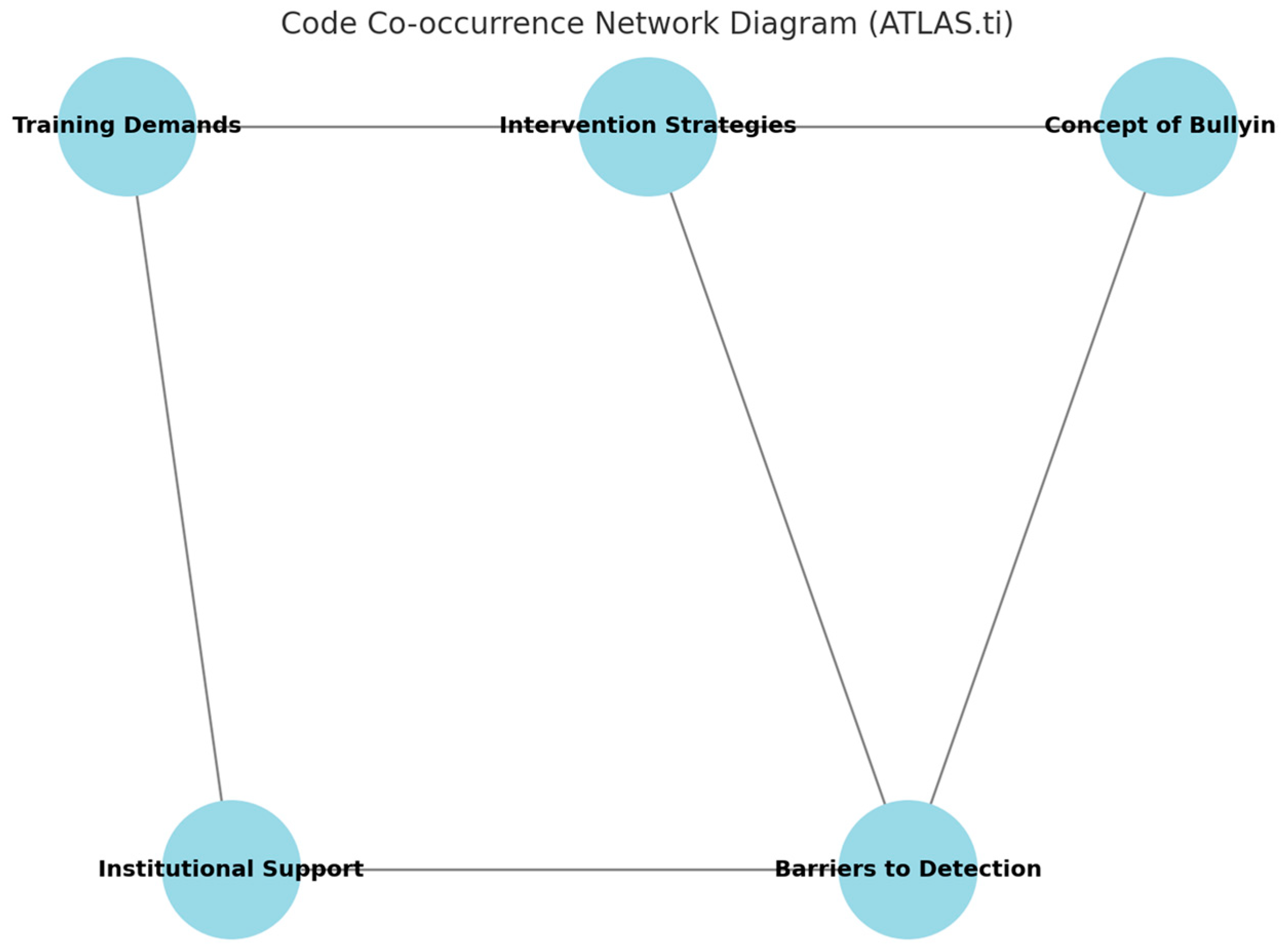
| Thematic Block | Item | Type of Response |
|---|---|---|
| Socio-demographic data | Gender | Male/Female/Other/Prefer not to say |
| Age | Open (years) | |
| Autonomous Community | Drop-down list (17 ACs) | |
| Years of professional experience | Less than 1 year/1–5/6–10/ 11–15/+15 | |
| Place of work | Urban/Rural/Semi-urban | |
| Educational level | Infant/Primary/Secondary/Secondary/VET/Others | |
| Employment status | Civil Servant/Interim/Substitute/Unemployed/Other | |
| Conceptions of harassment | Understands the difference between bullying and cyberbullying. | Likert scale 1 (Do not agree at all)—5 (Strongly agree) |
| The teacher believes these are serious problems | Likert 1–5 | |
| Believes it is important to be informed | Likert 1–5 | |
| Detection | Feels able to identify bullying | Likert 1–5 |
| Is familiar with signs of cyberbullying | Likert 1–5 | |
| The teacher believes it is essential to be on the lookout for possible cases | Likert 1–5 | |
| Prevention | Considers that it should be a school priority | Likert 1–5 |
| Believes that teachers should teach social-emotional skills | Likert 1–5 | |
| The teacher believes that family-school collaboration is key. | Likert 1–5 | |
| Intervention | Believes teachers should intervene immediately | Likert 1–5 |
| Agrees with disciplinary measures | Likert 1–5 | |
| Support for victims and perpetrators is important | Likert 1–5 | |
| Institutional documentation | Detection present in pedagogical documents | Likert 1 (Never)—5 (Always) |
| Behavioural observation indicators | Likert 1–5 | |
| Criteria for risk profiles | Likert 1–5 | |
| Sociometric questionnaires | Likert 1–5 | |
| Self-reports | Likert 1–5 | |
| Screening tests | Likert 1–5 | |
| Presence in the school | Prevention programmes | Likert 1–5 |
| Intervention programmes | Likert 1–5 | |
| Strategies and guidelines for action | Likert 1–5 | |
| Behavioural patterns | Likert 1–5 | |
| Evaluation methodologies | Likert 1–5 | |
| Teacher training | University education received | Likert 1–5 |
| Continuous training received | Likert 1–5 | |
| Training needs | Need for prevention training | Likert 1–5 |
| Need for intervention training | Likert 1–5 | |
| Need for strategy training | Likert 1–5 | |
| Need for training in behavioural patterns | Likert 1–5 | |
| Need for training in evaluation methodologies | Likert 1–5 |
| Understands the Difference Between Bullying and Cyberbullying. | ||||
|---|---|---|---|---|
| Frequency | Percentage | Percentage Valid | ||
| Valid | not at all in agreement | 2 | 0.9 | 0.9 |
| little agreement | 4 | 1.8 | 1.8 | |
| neither agree nor disagree | 18 | 8.0 | 8.0 | |
| in agreement | 48 | 21.4 | 21.4 | |
| totally in agreement | 152 | 67.9 | 67.9 | |
| Total | 224 | 100.0 | 100.0 | |
| Believes That Bullying and Cyberbullying Affect School Environment | ||||
|---|---|---|---|---|
| Frequency | Percentage | Percentage Valid | ||
| Valid | not at all in agreement | 1 | 0.4 | 0.4 |
| little agreement | 4 | 1.8 | 1.8 | |
| neither agree nor disagree | 15 | 6.7 | 6.7 | |
| in agreement | 33 | 14.7 | 14.7 | |
| totally in agreement | 171 | 76.3 | 76.3 | |
| Total | 224 | 100.0 | 100.0 | |
| Importance of Being Informed About Bullying and Cyberbullying | ||||
|---|---|---|---|---|
| Frequency | Percentage | Percentage Valid | ||
| Valid | not at all in agreement | 1 | 0.4 | 0.4 |
| little agreement | 5 | 2.2 | 2.2 | |
| neither agree nor disagree | 13 | 5.8 | 5.8 | |
| in agreement | 26 | 11.6 | 11.6 | |
| totally in agreement | 179 | 79.9 | 79.9 | |
| Total | 224 | 100.0 | 100.0 | |
| Data Normality | ||||
|---|---|---|---|---|
| Item | K-S Statistic | Sig. (p) | ||
| Understands the difference between bullying and cyberbullying. | 0.400 | 0.000 | ||
| Believes that bullying/cyberbullying affects the school environment | 0.450 | 0.000 | ||
| Importance of being informed about the issue | 0.469 | 0.000 | ||
| Spearman | ||||
| Understands the Difference Between Bullying and Cyberbullying. | ||||
| Spearman’s Rho | Understands the difference between bullying and cyberbullying. | Correlation coefficient | 1.000 | |
| Sig. (bilateral) | ||||
| N | 224 | |||
| Believes that bullying and cyberbullying affect school environment | Correlation coefficient | 0.592 | ||
| Sig. (bilateral) | 0.000 | |||
| N | 224 | |||
| Importance of being informed about bullying and cyberbullying | Correlation coefficient | 0.531 | ||
| Sig. (bilateral) | 0.000 | |||
| N | 224 | |||
| Feels Able to Identify Signs of Bullying | ||||
|---|---|---|---|---|
| Frequency | Percentage | Percentage Valid | ||
| Valid | not at all in agreement | 4 | 1.8 | 1.8 |
| little agreement | 19 | 8.5 | 8.5 | |
| neither agree nor disagree | 85 | 37.9 | 37.9 | |
| in agreement | 83 | 37.1 | 37.1 | |
| totally in agreement | 33 | 14.7 | 14.7 | |
| Total | 224 | 100.0 | 100.0 | |
| Familiarity with Warning Signs of Cyberbullying | ||||
|---|---|---|---|---|
| Frequency | Percentage | Percentage Valid | ||
| Valid | not at all in agreement | 9 | 4.0 | 4.0 |
| little agreement | 36 | 16.1 | 16.1 | |
| neither agree nor disagree | 80 | 35.7 | 35.7 | |
| in agreement | 69 | 30.8 | 30.8 | |
| totally in agreement | 30 | 13.4 | 13.4 | |
| Total | 224 | 100.0 | 100.0 | |
| It Is Essential to Be Vigilant in Cases of Harassment. | ||||
|---|---|---|---|---|
| Frequency | Percentage | Percentage Valid | ||
| Valid | not at all in agreement | 2 | 0.9 | 0.9 |
| little agreement | 3 | 1.3 | 1.3 | |
| neither agree nor disagree | 25 | 11.2 | 11.2 | |
| in agreement | 39 | 17.4 | 17.4 | |
| totally in agreement | 155 | 69.2 | 69.2 | |
| Total | 224 | 100.0 | 100.0 | |
| Normality Tests | |||
|---|---|---|---|
| Kolmogorov–Smirnov a | |||
| Statistic | gl | Sig. | |
| Feels able to identify signs of bullying | 0.210 | 224 | 0.000 |
| Familiarity with warning signs of cyberbullying | 0.186 | 224 | 0.000 |
| It is essential to be vigilant in cases of harassment. | 0.411 | 224 | 0.000 |
| Ranks | ||||
| Gender | N | Mean Rank | Rank Sum | |
| Feels able to identify signs of bullying | male | 78 | 121.72 | 9494.50 |
| female | 146 | 107.57 | 15,705.50 | |
| Total | 224 | |||
| Familiarity with warning signs of cyberbullying | male | 78 | 126.13 | 9838.50 |
| female | 146 | 105.22 | 15,361.50 | |
| Total | 224 | |||
| It is essential to be vigilant in cases of harassment. | male | 78 | 114.30 | 8915.50 |
| female | 146 | 111.54 | 16,284.50 | |
| Total | 224 | |||
| Test Statistics a | ||||
| Feels Able to Identify Signs of Bullying | Familiarity with Warning Signs of Cyberbullying | It Is Essential to Be Vigilant in Cases of Harassment. | ||
| Mann–Whitney U test | 4974.500 | 4630.500 | 5553.500 | |
| W for Wilcoxon | 15,705.500 | 15,361.500 | 16,284.500 | |
| Z | −1.650 | −2.401 | −0.374 | |
| Asymptotic sig. (bilateral) | 0.099 | 0.016 | 0.709 | |
| Prevention Should Be a School Priority | ||||
|---|---|---|---|---|
| Frequency | Percentage | Percentage Valid | ||
| Valid | little agreement | 9 | 4.0 | 4.0 |
| neither agree nor disagree | 24 | 10.7 | 10.7 | |
| in agreement | 61 | 27.2 | 27.2 | |
| totally in agreement | 130 | 58.0 | 58.0 | |
| Total | 224 | 100.0 | 100.0 | |
| The Role of Teachers in Social and Emotional Skills | ||||
|---|---|---|---|---|
| Frequency | Percentage | Percentage Valid | ||
| Valid | not at all in agreement | 2 | 0.9 | 0.9 |
| little agreement | 7 | 3.1 | 3.1 | |
| neither agree nor disagree | 29 | 12.9 | 12.9 | |
| in agreement | 49 | 21.9 | 21.9 | |
| totally in agreement | 137 | 61.2 | 61.2 | |
| Total | 224 | 100.0 | 100.0 | |
| Collaboration Between Teachers, Parents and Pupils | ||||
|---|---|---|---|---|
| Frequency | Percentage | Percentage Valid | ||
| Valid | not at all in agreement | 1 | 0.4 | 0.4 |
| little agreement | 1 | 0.4 | 0.4 | |
| neither agree nor disagree | 19 | 8.5 | 8.5 | |
| in agreement | 37 | 16.5 | 16.5 | |
| totally in agreement | 166 | 74.1 | 74.1 | |
| Total | 224 | 100.0 | 100.0 | |
| Normality Tests | |||
|---|---|---|---|
| Kolmogorov–Smirnov a | |||
| Statistic | gl | Sig. | |
| Prevention should be a school priority | 0.347 | 224 | 0.000 |
| The role of teachers in social and emotional skills | 0.364 | 224 | 0.000 |
| Collaboration between teachers, parents and pupils | 0.442 | 224 | 0.000 |
| Test Statistics a,b | |||
|---|---|---|---|
| Prevention Should be a School Priority | The Role of Teachers In Social and Emotional Skills | Collaboration Between Teachers, Parents and Pupils | |
| Kruskal–Wallis H | 2.102 | 2.045 | 0.515 |
| gl | 2 | 2 | 2 |
| Asymptotic sig. | 0.350 | 0.360 | 0.773 |
| Test Statistics a | |
|---|---|
| Criteria for identifying risk profiles—Behavioural observation indicators | |
| Z | −0.250 b |
| Asymptotic sig. (bilateral) | 0.803 |
| Test Statistics | ||||||||||||||||
|---|---|---|---|---|---|---|---|---|---|---|---|---|---|---|---|---|
| Immediate Intervention in Cases of Bullying | Consistent Disciplinary Measures | Support for Victims and Perpetrators | Detect ion of Behaviours in School Documents | Behavioural Observation Indicators | Criteria for Identifying Risk Profiles | Sociometric Questionnaires | Self-Reports for Harassment Assessment | Screening Tests | Programmes for Prevention | Intervention Programmes | Strategies and Guidelines for Action | Behavioural Patterns | Evaluation Instrument Methodologies | University Education Received | In-Service Training Received | |
| Chi-square | 208.545 a | 252.464 b | 465.107 a | 49.973 a | 34.571 a | 21.491 a | 8.366 a | 16.402 a | 24.750 a | 34.393 a | 42.205 a | 32.429 a | 30.732 a | 36.045 a | 38.366 a | 32.830 a |
| gl | 4 | 3 | 4 | 4 | 4 | 4 | 4 | 4 | 4 | 4 | 4 | 4 | 4 | 4 | 4 | 4 |
| Asymptotic sig. | 0.000 | 0.000 | 0.000 | 0.000 | 0.000 | 0.000 | 0.079 | 0.003 | 0.000 | 0.000 | 0.000 | 0.000 | 0.000 | 0.000 | 0.000 | 0.000 |
| Need for Prevention Training | |||||
|---|---|---|---|---|---|
| Frequency | Percentage | Percentage Valid | Cumulative Percentage | ||
| Valid | little agreement | 11 | 4.9 | 4.9 | 4.9 |
| neither agree nor disagree | 37 | 16.5 | 16.5 | 21.4 | |
| in agreement | 34 | 15.2 | 15.2 | 36.6 | |
| totally in agreement | 142 | 63.4 | 63.4 | 100.0 | |
| Total | 224 | 100.0 | 100.0 | ||
| Need for Intervention Training | |||||
|---|---|---|---|---|---|
| Frequency | Percentage | Percentage Valid | Cumulative Percentage | ||
| Valid | little agreement | 6 | 2.7 | 2.7 | 2.7 |
| neither agree nor disagree | 31 | 13.8 | 13.8 | 16.5 | |
| in agreement | 44 | 19.6 | 19.6 | 36.2 | |
| totally in agreement | 143 | 63.8 | 63.8 | 100.0 | |
| Total | 224 | 100.0 | 100.0 | ||
| Need for Training in Strategies | |||||
|---|---|---|---|---|---|
| Frequency | Percentage | Percentage Valid | Cumulative Percentage | ||
| Valid | little agreement | 8 | 3.6 | 3.6 | 3.6 |
| neither agree nor disagree | 28 | 12.5 | 12.5 | 16.1 | |
| in agreement | 44 | 19.6 | 19.6 | 35.7 | |
| totally in agreement | 144 | 64.3 | 64.3 | 100.0 | |
| Total | 224 | 100.0 | 100.0 | ||
| Need for Training in Behavioural Patterns | |||||
|---|---|---|---|---|---|
| Frequency | Percentage | Percentage Valid | Cumulative Percentage | ||
| Valid | not at all in agreement | 1 | 0.4 | 0.4 | 0.4 |
| little agreement | 5 | 2.2 | 2.2 | 2.7 | |
| neither agree nor disagree | 35 | 15.6 | 15.6 | 18.3 | |
| in agreement | 45 | 20.1 | 20.1 | 38.4 | |
| totally in agreement | 138 | 61.6 | 61.6 | 100.0 | |
| Total | 224 | 100.0 | 100.0 | ||
| Need for Training in Evaluation Methodologies | |||||
|---|---|---|---|---|---|
| Frequency | Percentage | Percentage Valid | Cumulative Percentage | ||
| Valid | not at all in agreement | 2 | 0.9 | 0.9 | 0.9 |
| little agreement | 15 | 6.7 | 6.7 | 7.6 | |
| neither agree nor disagree | 35 | 15.6 | 15.6 | 23.2 | |
| in agreement | 47 | 21.0 | 21.0 | 44.2 | |
| totally in agreement | 125 | 55.8 | 55.8 | 100.0 | |
| Total | 224 | 100.0 | 100.0 | ||
| Test Statistics a,b | |||||
|---|---|---|---|---|---|
| Need for Prevention Training | Need for Intervention Training | Need for Training in Strategies | Need for Training in Behavioural Patterns | Need for Training in Evaluation Methodologies | |
| Kruskal–Wallis H | 5.607 | 5.935 | 2.084 | 1.518 | 1.386 |
| gl | 4 | 4 | 4 | 4 | 4 |
| Asymptotic sig. | 0.230 | 0.204 | 0.720 | 0.823 | 0.847 |
| Main Category | Subcategory | Emerging Category | Representative Textual Quotation |
|---|---|---|---|
| Perception of bullying as violence | Harassment as persistent aggression | Bullying is associated with continuous aggression | “Bullying is when a pupil is constantly attacking another pupil, not just once, but many times.” |
| Intent to harm and imbalance of power | Intention and repetition required to be considered harassment | “For me there has to be an intention, it’s not a one-off fight. There is someone who has power over the other.” | |
| Understanding cyberbullying as a digital extension | Anonymity and social networks | The Internet facilitates invisible forms of harassment | “In networks it is more difficult to control it. It is anonymous, it is hidden. Often parents don’t even know about it.” |
| Difficulty in detecting | Teachers identify limitations in their detection | “We often don’t find out about cyberbullying until it has already erupted.” | |
| Boundary confusion or ambiguity | Confusion between conflict and harassment | Some teachers express doubts about what qualifies as bullying | “Sometimes they fight and we wonder if it’s bullying or just a conflict between equals.” |
| Evolution of the concept with professional experience | The definition has changed over the years | “I used to think bullying was just hitting. Now I see that there are more subtle things that also do a lot of harm.” |
| Main Category | Subcategory | Emerging Category | Representative Textual Quotation |
|---|---|---|---|
| Difficulties of direct observation | Invisibilisation of behaviour | Bullying does not always occur in the presence of the adult. | “It happens at recess or in the corridors, and we don’t see it. It’s not always obvious” |
| Subtle or psychological manifestations | Non-physical Behaviours make intervention difficult | “There are insults you don’t hear, looks, looks of contempt... you don’t see that easily.” | |
| Institutional silence | Lack of clear protocols | Organisational ambiguity in detection | “We don’t have a clear protocol for action. Everyone does what they can.” |
| Lack of training in detection | Lack of technical preparation and resources | “No one has trained us to detect if someone is being harassed.” | |
| Personal and environmental factors | Fear of student singling out | Victims often do not verbalise what they experience | “Children don’t say it, they are afraid that they will be laughed at more if they talk.” |
| Normalisation or minimisation | Some families or colleagues downplay the importance | “Sometimes colleagues say it’s kid stuff, or that we’re exaggerating.” |
| Categorical Code Matrix: Teaching Strategies and Intervention Frameworks | |||
|---|---|---|---|
| Main Category | Subcategory | Emerging Category | Representative Textual Quotation |
| Spontaneous intervention practices | Immediate teacher reaction | Intuitive intervention in visible situations | “If I see something strange, I stop it and then I talk to the kids separately.” |
| Individualised dialogue with students | Conversations as an informal intervention tool | “I prefer to talk to them before imposing a sanction. Listen first.” | |
| Personal and emotional boundaries | Feelings of helplessness or overwhelm | Negative emotion associated with lack of tools | “I feel overwhelmed a lot of the time. I don’t know if what I’m doing is right or if it’s making things worse.” |
| Doubts about when to intervene or escalate cases | Lack of clarity on the threshold for action | “Sometimes I don’t know whether to inform the head or to solve it in the classroom. There is no clear criteria.” | |
| Institutional barriers | Lack of internal coordination | Lack of shared action protocols | “Everyone does it in their own way. There is no school-wide policy for these cases.” |
| Fear of reaction from families or management | External pressure conditioning the intervention | “Sometimes you don’t want to call home because you know you’re going to get a hard time or you’re going to be challenged.” | |
| Main Category | Subcategory | Emerging Category | Representative Textual Quotation |
|---|---|---|---|
| Practical training needs | Direct bullying intervention | Applied training, not just theoretical | “We get lectures, yes, but what we need is to know how to act step by step in a real case.” |
| Tools to detect subtle signals | Training in early indicator monitoring | “There are many forms of bullying that go unnoticed. No one teaches us how to identify them.” | |
| Expectations towards the institution | Support from the management team | Need for formal support to make decisions | “Sometimes you perform and then the management tells you it wasn’t that big a deal. That’s demotivating. |
| Coordination with guidance and other actors | Networking as an expectation | “We feel alone. We need more joint Work with counselling or social services.” | |
| Structural shortcomings | Lack of dedicated resources | Lack of materials adapted to the school context | “We don’t have clear protocols and materials to work on this in class.” |
| Systematic continuous training | No continuity or updating of training | “Training comes late and once. It should be constant and adapted to what we are experiencing.” |
| Dimension | Interviews | Focus Group | Convergence | ||
| Concept of bullying | Intentionality, power, repetition | Difficulty of definition | High | ||
| Case detection | Invisibility, lack of training | Lack of protocol, silence | High | ||
| Intervention strategies | Intuitive practices, isolation | Lack of systematicity | High | ||
| Institutional support | Weak coordination and support | Lack of communication | High | ||
| Training and resources | Structural shortcomings | Absence in initial training | Total | ||
| Saturation | |||||
| Concept of Bullying | Barriers to Detection | Intervention Strategies | Institutional Support | Training Demands | |
| E.1 | 1 | 1 | 1 | 1 | 1 |
| E.2 | 1 | 1 | 1 | 1 | 1 |
| E.3 | 1 | 1 | 1 | 1 | 1 |
| E.4 | 1 | 1 | 1 | 0 | 1 |
| E.5 | 1 | 1 | 1 | 1 | 0 |
| E.6 | 1 | 1 | 1 | 0 | 1 |
| E.7 | 1 | 1 | 1 | 1 | 1 |
| E.8 | 1 | 1 | 1 | 1 | 1 |
| E.9 | 1 | 1 | 1 | 1 | 1 |
| Focus Group | 1 | 1 | 1 | 1 | 1 |
Disclaimer/Publisher’s Note: The statements, opinions and data contained in all publications are solely those of the individual author(s) and contributor(s) and not of MDPI and/or the editor(s). MDPI and/or the editor(s) disclaim responsibility for any injury to people or property resulting from any ideas, methods, instructions or products referred to in the content. |
© 2025 by the authors. Licensee MDPI, Basel, Switzerland. This article is an open access article distributed under the terms and conditions of the Creative Commons Attribution (CC BY) license (https://creativecommons.org/licenses/by/4.0/).
Share and Cite
Piedra, E.B.M.; Romero, C.S. Manifestations, Detection and Approach to Bullying and Cyberbullying from the Teachers’ Perspective: A Mixed Study in Spanish School Contexts. Educ. Sci. 2025, 15, 1384. https://doi.org/10.3390/educsci15101384
Piedra EBM, Romero CS. Manifestations, Detection and Approach to Bullying and Cyberbullying from the Teachers’ Perspective: A Mixed Study in Spanish School Contexts. Education Sciences. 2025; 15(10):1384. https://doi.org/10.3390/educsci15101384
Chicago/Turabian StylePiedra, Elena Blanca Martinez, and Cristina Sánchez Romero. 2025. "Manifestations, Detection and Approach to Bullying and Cyberbullying from the Teachers’ Perspective: A Mixed Study in Spanish School Contexts" Education Sciences 15, no. 10: 1384. https://doi.org/10.3390/educsci15101384
APA StylePiedra, E. B. M., & Romero, C. S. (2025). Manifestations, Detection and Approach to Bullying and Cyberbullying from the Teachers’ Perspective: A Mixed Study in Spanish School Contexts. Education Sciences, 15(10), 1384. https://doi.org/10.3390/educsci15101384







